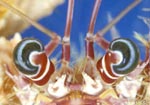
|
|
C MONARCH MUNCHING. U.S.
The caterpillar of our Monarch butterfly, Danaus plexippus, is a voracious
eater. The first thing it does after hatching is to eat its own eggshell
and eats - and eats - and eats milkweed leaves as much as its own weight in
one day. Milkweed's bitter taste remains in its body to protects it
against bird predators. Growing fast, it sheds skin and molts four or five
times in a few weeks before it builds its own cocoon.
Its metamorphosis from caterpillar into an adult is a miracle to behold.
Breaking out of its pupa shell or cocoon it pumps blood into its soft
wings and exoskeleton which hardens in hours, a transformation observed
yearly by many U.S. school children
Champion of insect migration, the Monarch butterfly
undertakes unique two thousand mile "relay flights" passing from one
generation to the next. To escape the cold, some may hibernate during the
winter in hollow trees or under bark. No one Monarch makes the entire trip
from Canada and the U.S. to our west coast or Mexico. As a butterfly it has
no mouthparts and cannot eat, only sip nectar. Its sole mission is: Find a
mate and die. With 200 species worldwide, Monarchs may live from two weeks
to 18 months.
|
 |
|
"Eyes of hermit crab " |
|
C-shaped arrangement of omatidia, Hawaii |
| |
|


